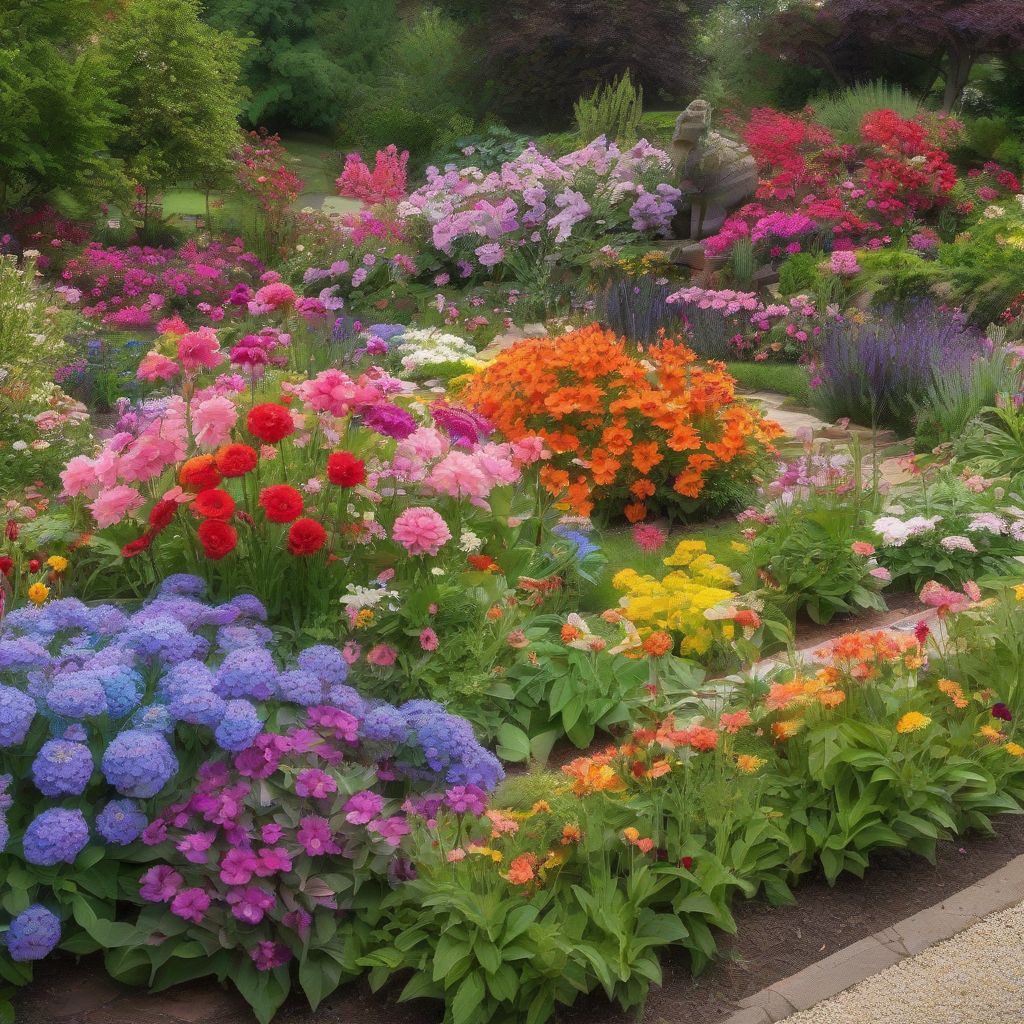Have you ever dreamt of having a vibrant, buzzing garden, bursting with colorful flowers from spring to fall? A garden that stops passersby in their tracks, captivated by its beauty? Achieving this dream isn’t as difficult as you might think. With a little planning and effort, you can transform your outdoor space into a breathtaking flower haven. Let’s dive into the steps for creating a colorful garden that sparks joy and invites you to linger amongst the blooms.
Understanding Your Garden Canvas
Before you grab your gardening gloves, take a moment to assess your canvas – your garden.
Sunlight Exposure: Your Garden’s Life Force
Just like us, flowers thrive in different light conditions. Observe how sunlight dances across your garden throughout the day:
- Full Sun: Does your garden bask in six or more hours of direct sunlight? Sun-loving flowers like coneflowers, zinnias, and black-eyed Susans will be in their element.
- Partial Shade: If your garden enjoys a balance of sun and shade (around four hours of direct sun), consider beauties like astilbes, bleeding hearts, and impatiens.
- Shade: Don’t despair if your garden is shaded by trees or structures. Hostas, ferns, and coral bells can brighten up even the shadiest corners.
Soil: The Foundation of Flourishing Flowers
The type of soil in your garden plays a vital role in the success of your flower power.
- Test Your Soil: A simple soil test from your local garden center can reveal its pH level and nutrient content, guiding you toward the best amendments to create an ideal growing environment.
- Amend if Needed: Most flowers thrive in well-drained soil. Amending with compost or other organic matter improves drainage, aeration, and nutrient retention – the recipe for happy roots!
 Colorful Flower Garden
Colorful Flower Garden
Designing Your Floral Masterpiece
Now for the fun part – choosing your floral cast of characters!
Color Palette: Painting with Blooms
- Complementary Colors: Opposites attract! Imagine pairing fiery red salvia with cool blue delphiniums for a striking contrast that energizes the senses.
- Analogous Colors: For a more harmonious and calming effect, choose colors that sit next to each other on the color wheel, like soothing purples, blues, and pinks.
- Monochromatic Marvel: Don’t underestimate the power of a single color. Plant different shades and textures of a single hue for a sophisticated and visually engaging display.
Bloom Time: A Symphony of Seasons
Extend the visual feast of your garden by selecting flowers with staggered bloom times:
- Spring Ephemerals: These fleeting beauties, like tulips and daffodils, herald the arrival of spring.
- Summer Showstoppers: From roses to lilies to coneflowers, summer offers an abundance of vibrant blooms.
- Autumn’s Grace: As summer fades, chrysanthemums, asters, and sedums provide a final burst of color.
Height and Texture: Adding Dimension and Drama
Create visual interest by incorporating plants of varying heights and textures:
- Vertical Accents: Tall flowers like hollyhocks and sunflowers draw the eye upward and add a sense of drama.
- Mid-Level Blooms: Coneflowers, daisies, and salvia fill the middle ground, creating a lush and abundant feel.
- Groundcovers: Low-growing plants like creeping phlox and sweet alyssum blanket the ground, suppressing weeds and adding texture.
Planting Your Floral Vision
With a plan in place, let’s get our hands dirty!
- Prepare the Soil: Loosen the soil with a garden fork or tiller, incorporating compost or other amendments as needed.
- Digging In: Dig holes slightly larger than the root balls of your plants, spacing them according to their mature sizes.
- Gentle Placement: Carefully remove plants from their containers, gently loosen any circling roots, and place them in the holes at the same depth they were growing in their containers.
- Backfill and Water: Fill the holes with soil, gently firming it around the roots. Water deeply to settle the soil and eliminate air pockets.
Ongoing Care: Nurturing Your Colorful Oasis
- Watering Wisely: Most flowers prefer a deep watering once or twice a week rather than frequent shallow watering.
- Feeding Your Flowers: Give your flowers a nutrient boost with a slow-release fertilizer or regular applications of compost tea.
- Deadheading for More Blooms: Regularly remove spent blooms to encourage your plants to produce more flowers.
Beyond the Basics: Expert Tips for a Flourishing Flower Garden
Ready to take your flower gardening game to the next level? Here are some insider tips:
- Embrace Companion Planting: Plant flowers that naturally deter pests near your vegetables for a healthier garden. For instance, marigolds repel nematodes and whiteflies.
- Attract Pollinators: Create a haven for bees, butterflies, and hummingbirds by planting nectar-rich flowers like bee balm, lavender, and salvia.
- Extend the Season with Succession Planting: Plant a new batch of cool-season flowers like pansies and violas in late summer for fall and early winter color.
Conclusion
Creating a colorful flower garden is a rewarding journey that engages all the senses. By understanding your garden’s unique conditions, choosing the right plants, and providing proper care, you’ll be amazed by the beauty you can cultivate. So go ahead, unleash your inner gardener, and watch as your garden transforms into a vibrant tapestry of color and life.
Now it’s your turn! What are your favorite flowers to plant for a colorful garden? Share your tips and photos in the comments below. Let’s inspire each other to create gardens that bring joy and beauty to our lives!
[amazon bestseller=”gardening books”]
